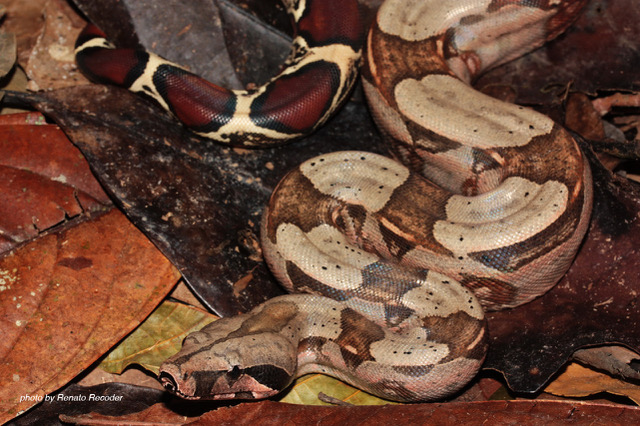
boa constrictor © Renato Recoder
The loss of animal traits is a recurrent theme in animal evolution. A few well-known examples are the loss of teeth in birds, the loss of eyes in animals that live in caves, and the loss of tail in humans. Understanding how traits got lost and identifying the genetic components that could have played a role in the loss of a trait is an intriguing question that many researchers aim to answer.
The most obvious genetic component that pops to mind are the genes. Genes carry the information for making proteins, the structural components of every process and tissue in the body. However, all cells in the body carry the exact same set of genes, yet, every animal is composed of many different tissues. The making of different tissues from the same set of genes is possible by spatial, temporal, and quantitative differences in the expression of the genes. This fine-tuning of gene expression is made possible by a second genetic component, the gene regulatory elements, that control where, when and how much of the gene will be expressed. Changes in the gene regulatory elements affect when and where a gene is expressed and can result in the formation of a different-sized or shaped structure, in a completely new structure, or in the loss of the structure.
The research group around Michael Hiller, affiliated with the Max Planck Institute of Molecular Cell Biology and Genetics (MPI-CBG), the Max Planck Institute for the Physics of Complex Systems (MPI-PKS), and the Center for Systems Biology Dresden (CSBD) is interested in understanding the link between changes in the DNA and the loss of animal structures. In their most recent work, the researchers performed a large-scale comparative study to identify the genomic changes associated with loss of limbs in snakes and degeneration of eyes in mammals that live underground.
For this analysis, it was necessary to have good quality genomes of many species, ideally of species that are evolutionarily close to the species of interest. While many mammal species have their genomes sequenced, allowing for powerful evolutionary analysis, only a few genomes of reptiles are publicly available. That’s why the researchers put great effort into sequencing and assembling the genome of the tegu lizard, as a first step in the work. In a recent publication in collaboration with Gene Myers at the MPI-CBG and the CSBD and the DRESDEN-concept Genome Center, they showed this assembly is the most contiguous and most complete reptile genome assembly to date.
With all the genomes at hand, the researchers performed a genome-wide comparative analysis to identify regions of the genome which were present and conserved in species which have limbs or well-developed eyes, but that were degenerated or deleted in snakes or in the subterranean mammals. The principle underlying this approach is that, if a DNA sequence has a function, it will be relatively shielded from mutations that could potentially destroy its function.
Instead of looking at the genes, the researchers focused on conserved regions outside of genes, with the aim of targeting the elements that regulate expression of genes. They found thousands of potential gene regulatory elements that were diverged or deleted in the genomes of snakes and of subterranean mammals. These elements are especially located in the vicinity of genes that are involved in the formation of limbs and eyes, and also overlap active gene regulatory elements detected experimentally. These results support the idea that these diverged regions are actual gene regulatory elements that control expression of limb/eye genes in species with normal limbs and eyes, and that the widespread DNA mutations that happened in snakes and subterranean mammals contributed to the mal-formation and loss of these structures.
"Although we don’t know yet which of these DNA changes were the underlying cause for the reduction or loss of limbs in snakes and of eyes in subterranean mammals, our study revealed a comprehensive list of genomic differences in these animals that are associated with the evolutionary loss of these traits", concludes Juliana G Roscito, the lead author in the study.
Juliana G. Roscito, Katrin Sameith, Genis Parra, Bjoern E. Langer, Andreas Petzold, Claudia Moebius, Marc Bickle, Miguel Trefaut Rodrigues & Michael Hiller: Phenotype loss is associated with widespread divergence of the gene regulatory landscape in evolution. Nature Communications, 9 November 2018.